25 th Wedding Anniversary Trip - The Silver
Safari: 2008-9
Cambodia and Thailand segment
Note: Click on pictures that have blue boarders to
see a full size image. Use browser
“back” button to return to travelogue.
January 15, 2009 Thursday (continued)
Warm welcome on a cool morning.
In Cambodia, we met Roy Clark and his protégé,
Pich.
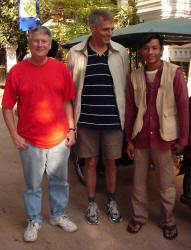 Clyde and I decide to stay in Siem Reap for at least a week.
We’ll then head down to Bangkok and celebrate the Chinese
New Year and get ready to head back to the U.S.A. We met
Roy’s son, Sinin. We haven’t met his friend Khan or
his granddaughter Aliza yet. Khan and his wife have four sons.
Sinin has a son on the way with his partner, so that will be two
grandkids for Roy in their family.
Clyde and I decide to stay in Siem Reap for at least a week.
We’ll then head down to Bangkok and celebrate the Chinese
New Year and get ready to head back to the U.S.A. We met
Roy’s son, Sinin. We haven’t met his friend Khan or
his granddaughter Aliza yet. Khan and his wife have four sons.
Sinin has a son on the way with his partner, so that will be two
grandkids for Roy in their family.
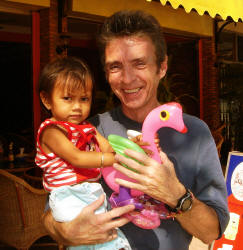 Roy’s Raison d’Etre Endeavors is helping many young
people in Cambodia.
Roy’s Raison d’Etre Endeavors is helping many young
people in Cambodia.
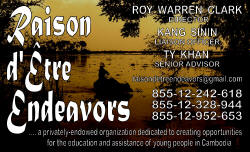 We’re staying at the Golden Banana. The room has no T.V.,
and that suits us fine. We had a great Khmer dinner (with Angkor
beer). After talking with Roy, we got the idea of taking the bus
down to Phnom Penh. That’s about a six hour trip. His
friend Channy can pick us up in Phnom Penh and take us to a local
hotel. The next day, we’ll go see the killing fields and
other sites associated with Pol Pot. Then we can get an Air Asia
flight to Bangkok.
We’re staying at the Golden Banana. The room has no T.V.,
and that suits us fine. We had a great Khmer dinner (with Angkor
beer). After talking with Roy, we got the idea of taking the bus
down to Phnom Penh. That’s about a six hour trip. His
friend Channy can pick us up in Phnom Penh and take us to a local
hotel. The next day, we’ll go see the killing fields and
other sites associated with Pol Pot. Then we can get an Air Asia
flight to Bangkok.
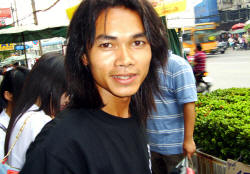 Roy, Clyde, and I had dessert afterwards at a roadside shop which
Sinin owns near the University. The Khmer dessert doesn’t
have a name, but it’s very much like halo-halo, so I like
it. The BBU (Build Bright University) let out classes at 9 p.m.,
so there was an armada of motorcycles as students headed out.
Sinin and his partner and their daughter, Aliza, joined us there
when Sinin got out of school at 9:00 p.m. I think that Sinin
would like to start an orphanage. He grew up on the streets of
Siem Reap without a mother or father.
Roy, Clyde, and I had dessert afterwards at a roadside shop which
Sinin owns near the University. The Khmer dessert doesn’t
have a name, but it’s very much like halo-halo, so I like
it. The BBU (Build Bright University) let out classes at 9 p.m.,
so there was an armada of motorcycles as students headed out.
Sinin and his partner and their daughter, Aliza, joined us there
when Sinin got out of school at 9:00 p.m. I think that Sinin
would like to start an orphanage. He grew up on the streets of
Siem Reap without a mother or father.
January 16, 2009 Friday
Securely Angkored.
Today we went with Pich in his tuk-tuk to see the colossal Angkor
Wat temple.
We saw Angkor Thom as well.
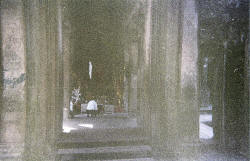 The most comforting thing about Angkor Wat were the stones on the
floor smoothed down by centuries of people who had walked before.
The bas relief epics make one think of a Christian
cathedral’s icons and stained glass windows, but you
don’t see stories of dancing and fighting on church walls.
The stone sculpture was well-preserved but the European and
Japanese tourists had decayed beyond possible restoration. (Just
kidding). The inner chambers were missing most of their Buddhas,
but some were in place, adorned with saffron, and being used for
worship with incense. At Ta Prohm, the trees had grown into and
over the temple buildings.
I was exhausted from seeing all the temples, so I took a nap when
we got back to our room. We had dinner at 7 p.m. tonight at a
great traditional Khmer restaurant with Roy. The food was
excellent and we talked a long time.
The most comforting thing about Angkor Wat were the stones on the
floor smoothed down by centuries of people who had walked before.
The bas relief epics make one think of a Christian
cathedral’s icons and stained glass windows, but you
don’t see stories of dancing and fighting on church walls.
The stone sculpture was well-preserved but the European and
Japanese tourists had decayed beyond possible restoration. (Just
kidding). The inner chambers were missing most of their Buddhas,
but some were in place, adorned with saffron, and being used for
worship with incense. At Ta Prohm, the trees had grown into and
over the temple buildings.
I was exhausted from seeing all the temples, so I took a nap when
we got back to our room. We had dinner at 7 p.m. tonight at a
great traditional Khmer restaurant with Roy. The food was
excellent and we talked a long time.
January 17, 2009 Saturday
Watch your step.
I want to cry this morning, but I heard our room gecko
chirp-barking this morning, which I always take to be a good
omen. Clyde decides to look for a better hotel, so he seeks out
what he remembers as the hotel which Roy recommended on our walk
to the desert shop. He booked us at the Millennium (I think it
was called the “New Millennium” back in 2000). It
costs $11 per night instead of $28, and it’s nicer, in my
judgment. Actually, Roy recommended the “Mandalay”
down the street, but it’s no big deal, except that we
can’t get wi-fi in the room. We went out in the country to
a wonderful red sandstone temple with intricate carvings.
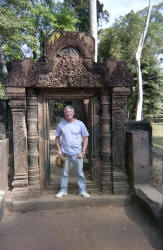 Pich drove the tuk-tuk about an hour and Clyde really liked the
countryside. It was much like the Philippines he remembered from
his childhood. At the temple, we spent awhile sitting up against
the outside wall in the shade, enjoying the Saturday morning, the
pond with pink lotus blossoms, parrots in the trees and about six
kinds of butterflies flitting around. It was very peaceful at
Banteay Srey.
Pich drove the tuk-tuk about an hour and Clyde really liked the
countryside. It was much like the Philippines he remembered from
his childhood. At the temple, we spent awhile sitting up against
the outside wall in the shade, enjoying the Saturday morning, the
pond with pink lotus blossoms, parrots in the trees and about six
kinds of butterflies flitting around. It was very peaceful at
Banteay Srey.
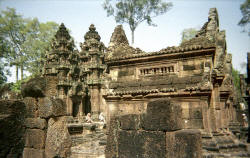 As trendsetters, our shady tourist-slacker example encouraged
Japanese tourists to do the same. The French were less inclined
to rest.
As trendsetters, our shady tourist-slacker example encouraged
Japanese tourists to do the same. The French were less inclined
to rest.
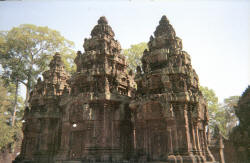 Clyde bought bootleg DVDs about the temples and the Khmer Rouge
from some hawkers, and we got a CD of traditional Khmer music
sold by handicap musicians who had been victims of landmines.
Clyde bought bootleg DVDs about the temples and the Khmer Rouge
from some hawkers, and we got a CD of traditional Khmer music
sold by handicap musicians who had been victims of landmines.
The temple of Banteay Samre was a stop on the way back.
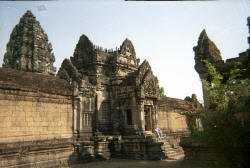 We also visited the amazing Aki Ra land mine museum and relief
fund. That’s a sobering account of how so many nations have
played Johnny Appleseed sowing millions of landmines to maim
anyone who comes upon them, friend or foe, war or no war. Each is
a living monument to senseless violence costing only $1.00 apiece
to produce and $1,000.00 apiece to deactivate.
We also visited the amazing Aki Ra land mine museum and relief
fund. That’s a sobering account of how so many nations have
played Johnny Appleseed sowing millions of landmines to maim
anyone who comes upon them, friend or foe, war or no war. Each is
a living monument to senseless violence costing only $1.00 apiece
to produce and $1,000.00 apiece to deactivate.
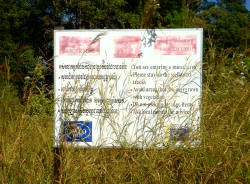 They’re ghastly. It gives new meaning to the phrase
“hostile wilderness” when your countryside has been
rigged to kill. Where do children play? Clyde and I
have seen plenty in one day. We had dinner tonight at a
good Indian restaurant which Roy recommended: the
Maharajah.
They’re ghastly. It gives new meaning to the phrase
“hostile wilderness” when your countryside has been
rigged to kill. Where do children play? Clyde and I
have seen plenty in one day. We had dinner tonight at a
good Indian restaurant which Roy recommended: the
Maharajah.
January 18, 2009 Sunday
A three-hour cruise.
Today we are to travel to the silk farm and Tonle Sap Lake.
We’ll be out in the countryside today. We ordered breakfast
at the “Why Not?” restaurant. The food is great
there.
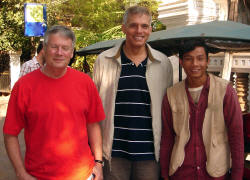 After Breakfast Pich took us out to the silk farm where we saw
how mulberry trees and silk worms are grown and how Artisans
d’Angkor are trained to weave both raw and fine silk. The
worms were just adorable, feasting on their freshly picked
mulberry leaves. Each group of worms has one keeper so that they
have the same scent and do not become sick as they are well-fed
and tended so that they can start weaving their cocoon. Once the
cocoon is completed, about 80% of them are boiled, dried out, or
otherwise wasted. Only 20% survive to mate. That’s better
odds than tourists have in the pubs. After the free tour, in the
tourist shop I buy a beautiful green Cambodian grass notebook
cover.
After Breakfast Pich took us out to the silk farm where we saw
how mulberry trees and silk worms are grown and how Artisans
d’Angkor are trained to weave both raw and fine silk. The
worms were just adorable, feasting on their freshly picked
mulberry leaves. Each group of worms has one keeper so that they
have the same scent and do not become sick as they are well-fed
and tended so that they can start weaving their cocoon. Once the
cocoon is completed, about 80% of them are boiled, dried out, or
otherwise wasted. Only 20% survive to mate. That’s better
odds than tourists have in the pubs. After the free tour, in the
tourist shop I buy a beautiful green Cambodian grass notebook
cover.
Later we saw Tonle Sap Lake which is a great fresh-water lake
that extends to the horizon.
The ethnic Vietnamese there live pretty much on the water, even
the school is on stilts. The basketball court is enclosed by a
bright blue metal grid so that the ball doesn’t hit the
water. The game must be a combination of basketball and racket
ball. Although we had already paid a sizable fee upfront, the
young boat skipper continuously gave us a tourist-trap speech
about making additional
“donations,” so we cut the “three hour
cruise” short and rescued ourselves. We had dinner at the
Millennium Hotel tonight, which was good. Two geckos watched over
our table. There was the usual tiny friendly one and a much
bigger customer who kept a steady watch over our heads, looking
for bugs. It’s getting warmer now in Siem Reap. The locals
like the change.
January 19, 2009 Monday
And no snakes, spiders, or rolling boulders.
CNN breathlessly tells the world that it will cover Obama’s
inauguration for 24 hours, though it only takes a few minutes at
noon on Tuesday Jan. 20, according to the 20th
Amendment to the Constitution. They even ran a poll as to how
well America thinks Obama is handling the transition. He’s
got positive ratings so far. But it will truly be a global event.
Thousands may freeze on the Capitol Mall, but there are no bad
seats on the planet.
Pich took us over to
Handicap International (Belgium) this morning. They
make prosthetic devices for landmine victims. One of their
medical workers gave us a good bit of information on their
organization and showed us their rehab area, which is a small
obstacle course for someone on an artificial leg. The staff
does quite a bit of dedicated social work with their clients as
well, since those who need the service are often poor. They
also educate people in rural areas about the dangers of landmines
and UXO (unexploded ordinance — bombs, mortars, grenades,
and other explosives dropped by the U.S.A. during the
1970’s).
Clyde and I then did more temple trekking. But I lost Clyde in
Preah Khan.
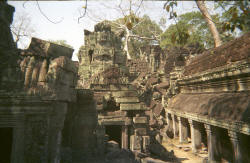 It’s billed as “highly explorable” which means
bring any kids you don’t mind losing. There were just too
many fascinating grungy gnarly trees and semi-ruins.
It’s billed as “highly explorable” which means
bring any kids you don’t mind losing. There were just too
many fascinating grungy gnarly trees and semi-ruins.
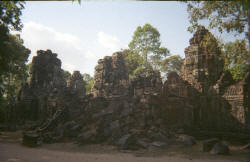 So, we got to know this temple well as we searched for each
other. Neak Pean was fascinating. It’s actually an island
temple which looks like it’s wrapped in a huge stone
snake’s coils.
So, we got to know this temple well as we searched for each
other. Neak Pean was fascinating. It’s actually an island
temple which looks like it’s wrapped in a huge stone
snake’s coils.
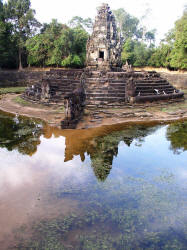 During the dry season you can see where the four pools are fed by
carved animal shrines which are spouting water features. There
were half a dozen kinds of butterflies flying around, including
one small one that looked like a pale spring violet on the wing.
During lunch, some little peeping chicks ran under our table to
escape a curious puppy. Their mother hen quickly found them and
averted the crisis. Ta Som was fun to wander around, with fig and
silk-cotton trees growing deep roots into the masonry. One huge
tree grew out of a huge Buddha head whose smile was cheerful for
a god who’d become a flower pot.
During the dry season you can see where the four pools are fed by
carved animal shrines which are spouting water features. There
were half a dozen kinds of butterflies flying around, including
one small one that looked like a pale spring violet on the wing.
During lunch, some little peeping chicks ran under our table to
escape a curious puppy. Their mother hen quickly found them and
averted the crisis. Ta Som was fun to wander around, with fig and
silk-cotton trees growing deep roots into the masonry. One huge
tree grew out of a huge Buddha head whose smile was cheerful for
a god who’d become a flower pot.
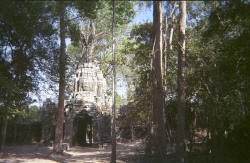 Ta Som was also interesting — the carvings looked less like
apsara chorus girls and more like characters with their own
stories and personalities. Later, we climbed through the mountain
temple of East Mebon, which was fun and had statues of elephants
at all four corners. We didn't visit the
West Mebon ruins which had been built by King
Udayadityavarman VII. His forgotten reign would have undoubtedly
endured for generations in epic story and song if anyone could
have pronounced his name correctly and with a straight face.
J
Ta Som was also interesting — the carvings looked less like
apsara chorus girls and more like characters with their own
stories and personalities. Later, we climbed through the mountain
temple of East Mebon, which was fun and had statues of elephants
at all four corners. We didn't visit the
West Mebon ruins which had been built by King
Udayadityavarman VII. His forgotten reign would have undoubtedly
endured for generations in epic story and song if anyone could
have pronounced his name correctly and with a straight face.
J
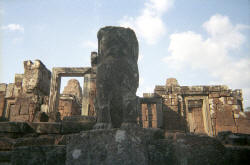 Pre Rup was the last temple mountain of the day, and a great view
of the countryside, including Angkor Wat in the distance. The
climb to the top was worth it.
Pre Rup was the last temple mountain of the day, and a great view
of the countryside, including Angkor Wat in the distance. The
climb to the top was worth it.
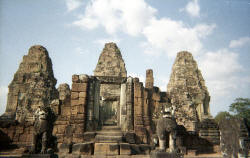
Although I thought I had already attained the end of my temple
appreciation for the day, I really liked the Prasat Kravan
temple, which is peaceful in warm late afternoon. It’s the
only one we have seen constructed of brick with intricate
bas-reliefs rendered in the brick. If this kind of work had been
done on paper by monks, it would now be treasured medieval
calligraphy under glass. If it had been carved in ivory, the
Chinese would never let it see the light of day. But, it’s
in brick, and even though it was reconstructed by archeologists,
it looks like a few good sneezes would cave in the towers. The
prayer chambers have the day’s offerings for Buddha
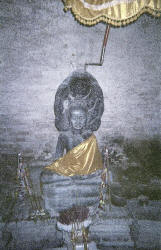 but the bas-reliefs on the inside brick walls are Hindu.
but the bas-reliefs on the inside brick walls are Hindu.
We met up with Roy and his good friend Khan this evening. Khan
took us out to a small neighborhood Khmer restaurant. The menu
was entirely in Cambodian, so we trusted him to order, and all
the food was good. We toasted a few times with Angkor beer. Khan
himself was born in 1978 at the height of the Khmer Rouge, and he
can hardly remember eating before he was ten. The very first
little mall has opened in Siem Reap. The Khmers haven’t
quite picked up on malls yet. Perhaps they need to import a few
thousand Filipino shoppers to create the right ambience.
J
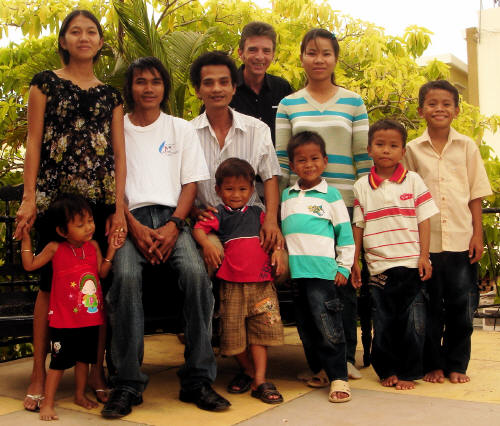 Roy in the back, his son Sinin's family left and Khan's family on
the right.
Roy in the back, his son Sinin's family left and Khan's family on
the right.
January 20, 2009 Tuesday
Obamathon.
It’s Inauguration Day in the United States. Clyde and I can
watch it live on T.V. but only at midnight. It’s also a
good day to get a haircut. Roy’s barber, Hak, gave me a
good $2.00 haircut. Hak explained that the music broadcasted up
and down the block was for a wedding nearby. Clyde was already
visiting with Sinin who introduced Clyde to some Cambodian music.
He has a beautiful home, not far from downtown. Not bad for
someone who spent his childhood with no parents, living on the
street. We looked around trying to find two wooden spirit houses
which we could have shipped back to North Carolina, but no luck
there. Every home and business has one in Cambodia, but
they’re typically made of painted concrete — not the
sort of thing we’d want to ship. We discover they’re
not made of wood, unless they’re homemade. The indoor
Chinese Buddhist shrines are wooden, but that’s not what
we’re looking for. The odd thing is, we’re not
Buddhists or animists, so it’s a curious item to purchase,
but it has caught our imagination. We had lunch at the Mandalay
trying to get wi-fi. Even when the hotel techie generously spends
lots of time fidgeting with our computer; no luck. There is an
incompatibility somewhere.
January 21, 2009 Wednesday
Temple doggin’
It’s amazing that we’ve had not a single drop of rain
on our visit to Cambodia so far. It really is the dry season, and
the cool dry season at that. This morning, we had a light
breakfast at the Millennium guest house. Pich retrieved us at
9:00 a.m. and we went to the Roulos temples.
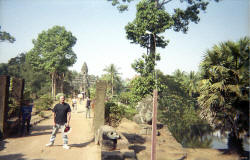 At Bakong, there were little stacks of rocks arranged near the
empty and crumbling old stupas. These are the work of the Wee
Khmer who live in the dark corners of Bakong and only scamper out
at night to stack rocks in Celtic style. Clyde says that I should
actually read the guide book history of the temples, but this is
my story, and I’m sticking to it. Oh yes, and the typical
temple mountain confirms Von Däniken’s “ancient
astronauts” hypothesis. Clearly, the block steps were built
for alien creatures with spidery appendages utterly unlike our
own.
J
Each of these temples does have its own history and story, but
the crumbling laterite and sandstone architecture seems to grow
right out of your subconscious. It’s hard for my
imagination not to get fully involved.
At Bakong, there were little stacks of rocks arranged near the
empty and crumbling old stupas. These are the work of the Wee
Khmer who live in the dark corners of Bakong and only scamper out
at night to stack rocks in Celtic style. Clyde says that I should
actually read the guide book history of the temples, but this is
my story, and I’m sticking to it. Oh yes, and the typical
temple mountain confirms Von Däniken’s “ancient
astronauts” hypothesis. Clearly, the block steps were built
for alien creatures with spidery appendages utterly unlike our
own.
J
Each of these temples does have its own history and story, but
the crumbling laterite and sandstone architecture seems to grow
right out of your subconscious. It’s hard for my
imagination not to get fully involved.
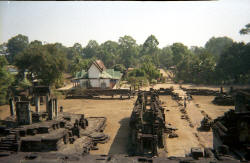
We saw an interesting sleek and shiny lizard near one of the
entrances with a white belly and orange almost coppery color on
top. He froze when he spotted us. The warm temple rocks are a
great place for lizard lounging.
I called the temple of Preah Ko “praying cows”
because there are four cow statues kneeling bucolically at the
entrance, contentedly facing the temple. They’re the only
statues of cows I’ve seen at the Angkor temples. We stop
by a local orphanage and buy some of the kids’ leather
shadow puppets we liked. The boys wanted to be photographed with
their handiwork, which was fine with us. Their workmanship is
excellent. I think Clyde wanted to adopt all of them.
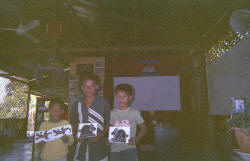
We then go back to the Millennium to fetch my laptop and then
have lunch by the pool at the Golden Banana where we can hook
into their wi-fi.
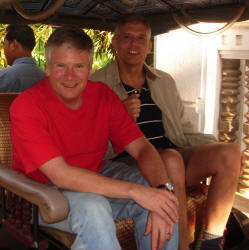 We both look through e-mails and answer a few that are urgent.
Steve Dobbins can’t pick us up at the airport Tuesday
evening, but Thomas Sherratt will meet us. It snowed in North
Carolina yesterday, and Elon had to cancel classes Tuesday
afternoon.
We both look through e-mails and answer a few that are urgent.
Steve Dobbins can’t pick us up at the airport Tuesday
evening, but Thomas Sherratt will meet us. It snowed in North
Carolina yesterday, and Elon had to cancel classes Tuesday
afternoon.
We then go back out to further explore the Ta Prohm temple. Ta
Prohm is famous as a set for jungle action films — with
many kapok trees growing roots into the temple walls.
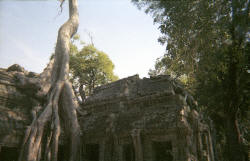 There’s actually a moat around it which we inexplicably
didn’t see the first time we visited. It was great to
venture into new passageways and nooks of the temple, and over
piles of rubble to see detailed old carvings on the walls. It
was annoying to have to push aside generic signs saying something
about “danger,” “no entry” and
“do not climb.” Had there been serious danger,
the signs would surely have been in Japanese and French as well,
and not just in Cambodian and English. This place would be
a paradise for kids to rummage through.
There’s actually a moat around it which we inexplicably
didn’t see the first time we visited. It was great to
venture into new passageways and nooks of the temple, and over
piles of rubble to see detailed old carvings on the walls. It
was annoying to have to push aside generic signs saying something
about “danger,” “no entry” and
“do not climb.” Had there been serious danger,
the signs would surely have been in Japanese and French as well,
and not just in Cambodian and English. This place would be
a paradise for kids to rummage through.
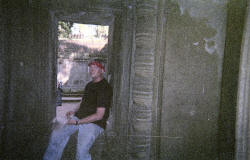
We walked up the Siem Reap River with Roy this evening, which is
a very nice promenade. He took us to a Khmer BBQ restaurant which
has a unique BBQ pot at the table where you can grill or boil
your choice of meat from a great buffet.
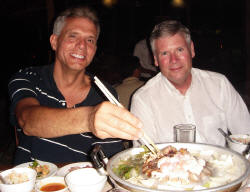 I couldn’t identify every dish I tasted, but it was all
great. The floor captain, Mingli, was very helpful. He also did
a good job directing the staff and keeping the customers happy.
Clyde found out that he’s vegetarian, but he does a good
job advising on meat too, and mixing spices. He’s also only
16. You wonder what a kid like that would accomplish if he had
Western opportunities and the support of an older generation
which hadn’t been killed by the Khmer Rouge.
I couldn’t identify every dish I tasted, but it was all
great. The floor captain, Mingli, was very helpful. He also did
a good job directing the staff and keeping the customers happy.
Clyde found out that he’s vegetarian, but he does a good
job advising on meat too, and mixing spices. He’s also only
16. You wonder what a kid like that would accomplish if he had
Western opportunities and the support of an older generation
which hadn’t been killed by the Khmer Rouge.
January 22, 2009 Thursday
War and Pieces.
Clyde had breakfast with Roy this morning who shared some good
photos of Roy and friends. I joined in a Christian praise and
worship service upstairs on the roof of our guest house with some
Western young people from “Youth With A Mission,”
mainly from Australia, U.S.A., and Canada, but also Hong Kong and
Finland. They are there to help the orphans in Cambodia. Their
team leaders are a couple from Australia. We sang some praise
songs to the guitar, read scripture and prayed together.
Clyde and I visited the National Angkor Museum today. We paid
Pich’s admission so that he could spend time learning about
Khmer history, art, and architecture. He appreciated it, but he
has less tolerance for snooze-inducing display chambers of stele
and artifacts than we do. The media technology was first-rate. It
was a great way to follow-up our treks through the towers by
figuring out the context. The gallery of 1000 Buddhas was
impressive. Pich wanted us to see the war museum down the street,
which was basically a lot with rusted American and Soviet
artillery guns and tanks from the war years. After seeing the
Angkor Museum’s accounts of linga and worship of Shiva the
destroyer, the phallic mortar and anti-aircraft guns showed the
cult of destruction lives on.
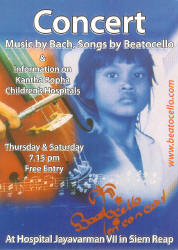 On a more optimistic note, Pich,
Clyde, and I went to the Hospital Jayavarman VII that evening to
hear a cello concert by
Dr. Beat Richner
who uses his concerts to raise money for Kantha Bopha
Children’s Hospitals. He’s a pretty inspiring
healer who provides free first-rate care for Cambodian kids who
would otherwise die. That means he’s also spent years
raising money to build hospitals.
On a more optimistic note, Pich,
Clyde, and I went to the Hospital Jayavarman VII that evening to
hear a cello concert by
Dr. Beat Richner
who uses his concerts to raise money for Kantha Bopha
Children’s Hospitals. He’s a pretty inspiring
healer who provides free first-rate care for Cambodian kids who
would otherwise die. That means he’s also spent years
raising money to build hospitals.
January 23, 2009 Friday
Kicks on Route 6 to Phnom Penh.
We took the 6 hour bus trip from Siem Reap south to Phnom
Penh. It was sad to leave Roy and Pich at the bus station,
but, with hugs all ’round, we said
“good-bye.” Roy had reserved us seats in the
front of the bus for Clyde’s long legs. We’re
the only foreigners on board.
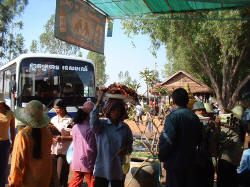 The bus had Cambodian video karaoke, a Chinese martial arts film
with bizarre English subtitles. I dubbed the film
“Hidden Dragon, Crashing Boor.” Roy’s
smiling friend Channy
The bus had Cambodian video karaoke, a Chinese martial arts film
with bizarre English subtitles. I dubbed the film
“Hidden Dragon, Crashing Boor.” Roy’s
smiling friend Channy
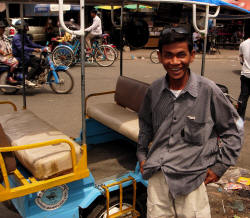 met us at the bus station and took us to Her Royal Highness.
It’s a budget hotel near the riverfront
— and only $15.00 per night. We’ll just need it for
two nights. Phnom Penh is a big bustling city, but lovely. The
countryside between Siem Reap and Phnom Penh had more rice
paddies as we got closer to the river. We decided to drop in at
the Anchor Bar near the hotel for dinner. The owner and her
teenage son and daughter were lots of fun. We played some board
games, at which I lost. We found a little Internet shop across
the street and answered a few e-mails. Clyde teased one of the
employees about letting his son spend too much time playing games
on the computer without doing his homework. A bunch of them were
competing with each other playing the computer action game
“Stadium.”
met us at the bus station and took us to Her Royal Highness.
It’s a budget hotel near the riverfront
— and only $15.00 per night. We’ll just need it for
two nights. Phnom Penh is a big bustling city, but lovely. The
countryside between Siem Reap and Phnom Penh had more rice
paddies as we got closer to the river. We decided to drop in at
the Anchor Bar near the hotel for dinner. The owner and her
teenage son and daughter were lots of fun. We played some board
games, at which I lost. We found a little Internet shop across
the street and answered a few e-mails. Clyde teased one of the
employees about letting his son spend too much time playing games
on the computer without doing his homework. A bunch of them were
competing with each other playing the computer action game
“Stadium.”
January 24, 2009 Saturday
Village Commons.
Channy drove us out to Choenung Ek village south of Phnom Penh.
These are the notorious “killing fields.” There
is a white marble pagoda-crowned memorial in the center of the
fields which displays thousands of human skulls.
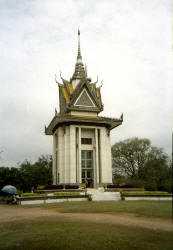 The grassy field contains several old trees and grass-covered
depressions in the ground. The depressions are the sites of
excavated mass graves. One gnarled old tree was where a
loudspeaker was hung to drown out the noise of the victims’
moaning. Children were beaten against the other tree before being
dumped into a mass grave next to it. The meadow has an eerie
quietness as tourists walk through. The atmosphere reminded me of
the campus of Columbine high school when I visited it only a week
after the shootings: it’s a silent weight which wraps
around you, like scuba diving far below the surface. The only
bird sound is from a species which I heard at Angkor Wat a few
days ago and had dubbed “the dripping faucet.”
It sings one repeated monotonous note. It fits here. There are
many types of butterflies, tiny lemon ones, sky-blue ones, and
others. One couple of tourists had a toddler who insisted on
chasing the butterflies across grave sites. Maybe the butterflies
are ghosts of murdered children.
The grassy field contains several old trees and grass-covered
depressions in the ground. The depressions are the sites of
excavated mass graves. One gnarled old tree was where a
loudspeaker was hung to drown out the noise of the victims’
moaning. Children were beaten against the other tree before being
dumped into a mass grave next to it. The meadow has an eerie
quietness as tourists walk through. The atmosphere reminded me of
the campus of Columbine high school when I visited it only a week
after the shootings: it’s a silent weight which wraps
around you, like scuba diving far below the surface. The only
bird sound is from a species which I heard at Angkor Wat a few
days ago and had dubbed “the dripping faucet.”
It sings one repeated monotonous note. It fits here. There are
many types of butterflies, tiny lemon ones, sky-blue ones, and
others. One couple of tourists had a toddler who insisted on
chasing the butterflies across grave sites. Maybe the butterflies
are ghosts of murdered children.
Afterwards, we went to Toul Sleng genocide museum (the former
prison and high school) S-21. Its former classrooms now contain
only rusted metal beds and electrical wires hanging from the
ceilings — part of the regime’s
“education” prior to execution. After finding out
what they did with the pull-up exercise bars outside, you can
never look at a gym the same way again. There are also many black
and white photographs of the prisoners. The Khmer Rouge’s
victim faces made quite a human gallery. That’s a grim
tour, but well worth it. I’m thinking about Jordan
Mohr’s paper on genocide. It was a perfect storm in
Cambodia. Could it happen in America? I don’t ask the
Cambodians I meet about their family or personal experience of
the Pol Pot regime, but the looks on their faces when I mention
visiting Cheoung Ek or S-21 says it all. Not a topic for casual
conversation. We don’t press Channy for the story about
losing his parents.
Saturday afternoon, Channy had lunch with us at a good and
inexpensive corner Khmer restaurant he likes. He has a great
sense of humor. The route is through the market area. Sitting in
a tuk-tuk, the interaction of hordes of motorbikes, pedestrians,
autos, cycles, and tuk-tuks reminded me most of all of the fish I
saw in the coral reefs of Calibao Island in the Philippines. They
look as though they should all run into each other, but the
flows, twists turns, and dives somehow all work together. The
market itself is like an immense coral reef.
Channy let us off at the Royal Palace and the Silver
Pagoda. The Main Throne Hall was closed to tourists,
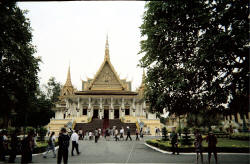
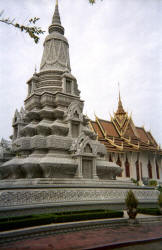 but the Silver Pagoda made up for it. We sat quietly on the rug
watching tourists from different countries show different sorts
of obeisance and respect to Buddha with incense, bows, and quiet
attention in the midst of the bustling crowd. As we sat peering
at the floor between the rugs, the inscribed tiles looked odd:
something like burnished tin or pewter. When I got a better look,
I realized that all the tiles are solid silver though mostly
covered by rugs in front of the glass-enclosed solid gold
diamond-studded standing Buddha and the emerald Buddha elevated
behind it.
but the Silver Pagoda made up for it. We sat quietly on the rug
watching tourists from different countries show different sorts
of obeisance and respect to Buddha with incense, bows, and quiet
attention in the midst of the bustling crowd. As we sat peering
at the floor between the rugs, the inscribed tiles looked odd:
something like burnished tin or pewter. When I got a better look,
I realized that all the tiles are solid silver though mostly
covered by rugs in front of the glass-enclosed solid gold
diamond-studded standing Buddha and the emerald Buddha elevated
behind it.
We had dinner tonight across from the Arrow Inn. The business
supports a tiny craft shop across the street which features the
work of villagers who need the income. We bought some items,
including a painting of a sunrise by one 15 year-old girl, named
Phalla.
January 25, 2009 Sunday
Lunar Peace and Quiet.
I think that people are practicing for the Chinese New Year. I
hear the drums and fireworks this morning. But that’s all
the celebration I heard. This afternoon, Channy took us to the
airport for our Air Asia flight to Bangkok. The roads were
unusually quiet, which Channy attributed to Chinese and
Vietnamese leaving town for Sihanoukville and Siem Reap for the
holiday. Roy sent plenty of info on a possible hotel for us in
Bangkok: the New Fuji, where he’s stayed 40 times or
more. He said to mention that we’re friends of “Mr.
Roy.” I hope that brings a smile to their faces. The
hotel is small and low-budget, but we got one of the rooms which
Roy recommended as best (no. 505). We found their sister hotel,
the “Trocadero,” down the street and had supper
there, and then got chocolate ice cream at an Indian restaurant
on the way back.
January 26, 2009 Monday
“Beware of your valuable possessions!”
That Thai tourist sign has some Buddhist wisdom in it. We made
tour plans for our single day in Bangkok this morning. Clyde and
I wanted to take the cheap river ferry up the Chao Phraya to the
Grand Palace. So, we hiked over to the pier through nearby
streets paved with semi-precious gem stores (or, as Clyde puts
it, “semi-conscious” gems, since I wasn’t quite
awake). We also found the ferries were sardine-crammed with
tourists. That’s not the way we wanted to travel, so we got
a cab to the Grand Palace. That drive brought back memories of
our visit in 1991. There are many poster-sized images and
portraits of the King on display along the boulevard and at
government offices.
Of all the structures in the Palace complex, the Phra Wiharn Yod
was my favorite. It’s got an intricate tile and multi-color
jewel-encrusted roof which only a pastry chef could have whipped
up out of sugar and cream.
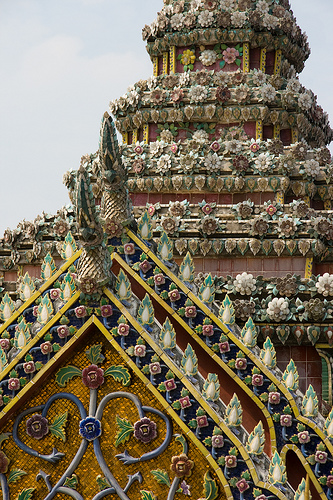 It’s Chinese New Year, and the beginning of the Lunar Year,
so there are loads of holiday visitors and traffic. The locals
dipped lotus stems in holy water at the Wat Phra Kaew temple next
to the Grand Palace and anointed their heads. Clyde pointed out
one lotus blossom in a pool which had a dozen or so very tiny
bees on the blossom. These little bees are stingless. You
couldn’t get all these blossoms without them. We spent a
few respectful minutes sitting on the floor at the Royal
Monastery of the Emerald Buddha. After touring the Palace and
the Throne Room, we walked in the direction of China Town. Most
stores were closed for the holiday, but there was a huge green
statue of Ganesha the elephant god in the street which was
getting its share of votive candles and marigold wreaths. It was
a very happy looking idol ready to offer good luck and success.
We immediately found an air-conditioned street mall with a
vegetarian food court. Coincidence? After a long
traffic-choked cab ride back to the New Fuji, I rested while
Clyde shopped for a new belt on Siloam Street. We went back to
the Indian restaurant we discovered the night before. We ordered
some masala cheese uttapam (sort of South India pizza) and some
delicious sweet and minty rabdi for dessert. We have to get up
early tomorrow morning to catch our flight on All Nippon
Airlines.
It’s Chinese New Year, and the beginning of the Lunar Year,
so there are loads of holiday visitors and traffic. The locals
dipped lotus stems in holy water at the Wat Phra Kaew temple next
to the Grand Palace and anointed their heads. Clyde pointed out
one lotus blossom in a pool which had a dozen or so very tiny
bees on the blossom. These little bees are stingless. You
couldn’t get all these blossoms without them. We spent a
few respectful minutes sitting on the floor at the Royal
Monastery of the Emerald Buddha. After touring the Palace and
the Throne Room, we walked in the direction of China Town. Most
stores were closed for the holiday, but there was a huge green
statue of Ganesha the elephant god in the street which was
getting its share of votive candles and marigold wreaths. It was
a very happy looking idol ready to offer good luck and success.
We immediately found an air-conditioned street mall with a
vegetarian food court. Coincidence? After a long
traffic-choked cab ride back to the New Fuji, I rested while
Clyde shopped for a new belt on Siloam Street. We went back to
the Indian restaurant we discovered the night before. We ordered
some masala cheese uttapam (sort of South India pizza) and some
delicious sweet and minty rabdi for dessert. We have to get up
early tomorrow morning to catch our flight on All Nippon
Airlines.
January 27, 2009 Tuesday
“Departures.”
The Suvarnabhumi Airport is Japanese-sleek and security-sterile.
After security, we waited in a service-less holding area outside
our locked departure waiting area. Our flight stews
couldn’t immediately figure out how to open the lock to our
gate, but Clyde did it for them. (With his opposable thumbs,
he’s a very clever primate). All Nippon Airlines was very
eager to please, and we were eager to be pleased. I saw a
wonderful Japanese film, “Departures,” with English
subtitles. It was a sort of Japanese “Six Feet Under”
story. An out-of-work cellist gets a job assisting with
“encoffinment” which is the preparation of the body
for burial, in the presence of the family — very much about
ritual, care, and conferring dignity in death. We got quite
spoiled on the flight to Japan, with attention and amenities
before airport security confiscated Clyde’s unopened little
bottle of Chardonnay and we were crammed into our American
Airlines coach seats for 11 hours from Japan to Chicago. When I
pushed up the window shutter in the middle of our
“night,” snow-covered Illinois was super bright
outside. Thomas Sherratt met us at RDU after our short evening
flight from Chicago to North Carolina. It was good to be home.
 Clyde and I decide to stay in Siem Reap for at least a week.
We’ll then head down to Bangkok and celebrate the Chinese
New Year and get ready to head back to the U.S.A. We met
Roy’s son, Sinin. We haven’t met his friend Khan or
his granddaughter Aliza yet. Khan and his wife have four sons.
Sinin has a son on the way with his partner, so that will be two
grandkids for Roy in their family.
Clyde and I decide to stay in Siem Reap for at least a week.
We’ll then head down to Bangkok and celebrate the Chinese
New Year and get ready to head back to the U.S.A. We met
Roy’s son, Sinin. We haven’t met his friend Khan or
his granddaughter Aliza yet. Khan and his wife have four sons.
Sinin has a son on the way with his partner, so that will be two
grandkids for Roy in their family.
 Roy’s Raison d’Etre Endeavors is helping many young
people in Cambodia.
Roy’s Raison d’Etre Endeavors is helping many young
people in Cambodia.
 We’re staying at the Golden Banana. The room has no T.V.,
and that suits us fine. We had a great Khmer dinner (with Angkor
beer). After talking with Roy, we got the idea of taking the bus
down to Phnom Penh. That’s about a six hour trip. His
friend Channy can pick us up in Phnom Penh and take us to a local
hotel. The next day, we’ll go see the killing fields and
other sites associated with Pol Pot. Then we can get an Air Asia
flight to Bangkok.
We’re staying at the Golden Banana. The room has no T.V.,
and that suits us fine. We had a great Khmer dinner (with Angkor
beer). After talking with Roy, we got the idea of taking the bus
down to Phnom Penh. That’s about a six hour trip. His
friend Channy can pick us up in Phnom Penh and take us to a local
hotel. The next day, we’ll go see the killing fields and
other sites associated with Pol Pot. Then we can get an Air Asia
flight to Bangkok.

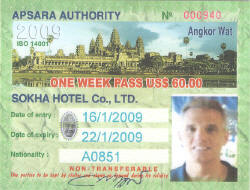
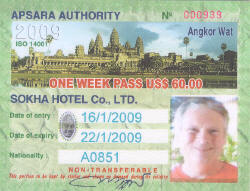
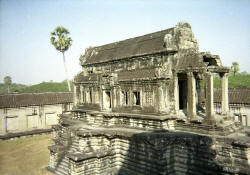
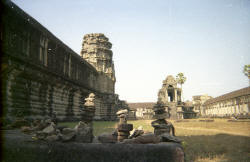
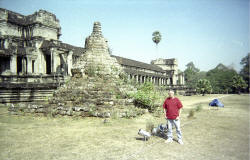
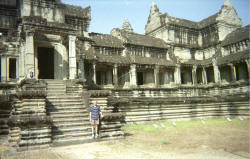
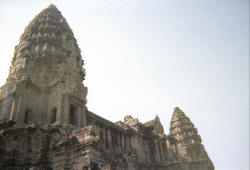
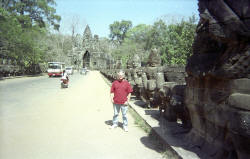
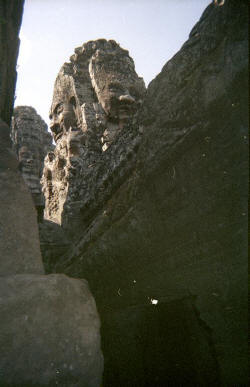

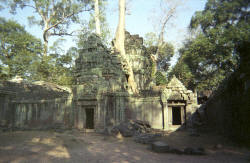
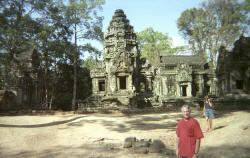
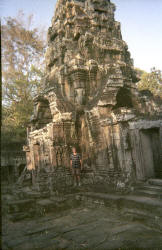






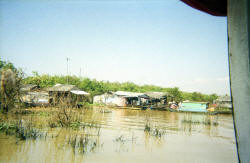
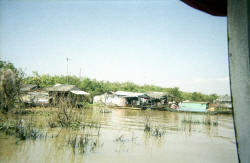
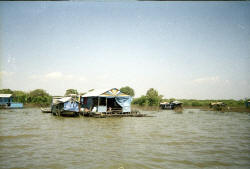





















 It’s Chinese New Year, and the beginning of the Lunar Year,
so there are loads of holiday visitors and traffic. The locals
dipped lotus stems in holy water at the Wat Phra Kaew temple next
to the Grand Palace and anointed their heads. Clyde pointed out
one lotus blossom in a pool which had a dozen or so very tiny
bees on the blossom. These little bees are stingless. You
couldn’t get all these blossoms without them. We spent a
few respectful minutes sitting on the floor at the Royal
Monastery of the Emerald Buddha. After touring the Palace and
the Throne Room, we walked in the direction of China Town. Most
stores were closed for the holiday, but there was a huge green
statue of Ganesha the elephant god in the street which was
getting its share of votive candles and marigold wreaths. It was
a very happy looking idol ready to offer good luck and success.
We immediately found an air-conditioned street mall with a
vegetarian food court. Coincidence? After a long
traffic-choked cab ride back to the New Fuji, I rested while
Clyde shopped for a new belt on Siloam Street. We went back to
the Indian restaurant we discovered the night before. We ordered
some masala cheese uttapam (sort of South India pizza) and some
delicious sweet and minty rabdi for dessert. We have to get up
early tomorrow morning to catch our flight on All Nippon
Airlines.
It’s Chinese New Year, and the beginning of the Lunar Year,
so there are loads of holiday visitors and traffic. The locals
dipped lotus stems in holy water at the Wat Phra Kaew temple next
to the Grand Palace and anointed their heads. Clyde pointed out
one lotus blossom in a pool which had a dozen or so very tiny
bees on the blossom. These little bees are stingless. You
couldn’t get all these blossoms without them. We spent a
few respectful minutes sitting on the floor at the Royal
Monastery of the Emerald Buddha. After touring the Palace and
the Throne Room, we walked in the direction of China Town. Most
stores were closed for the holiday, but there was a huge green
statue of Ganesha the elephant god in the street which was
getting its share of votive candles and marigold wreaths. It was
a very happy looking idol ready to offer good luck and success.
We immediately found an air-conditioned street mall with a
vegetarian food court. Coincidence? After a long
traffic-choked cab ride back to the New Fuji, I rested while
Clyde shopped for a new belt on Siloam Street. We went back to
the Indian restaurant we discovered the night before. We ordered
some masala cheese uttapam (sort of South India pizza) and some
delicious sweet and minty rabdi for dessert. We have to get up
early tomorrow morning to catch our flight on All Nippon
Airlines.